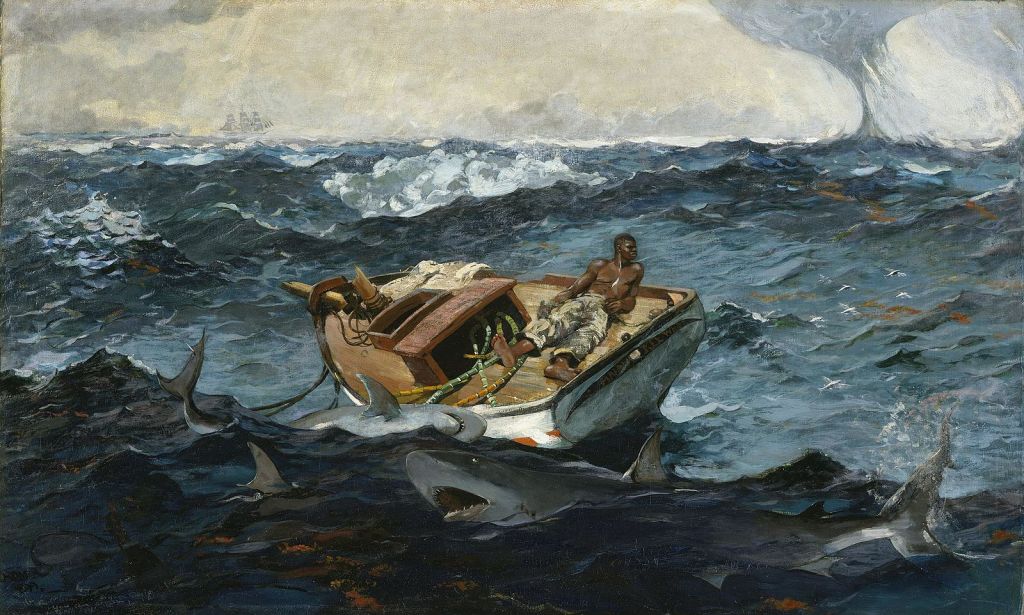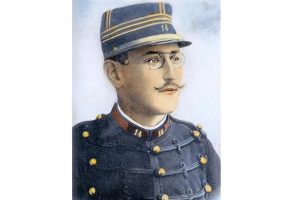A new show on the work of Winslow Homer at New York’s Metropolitan Museum of Art makes the case that he is a painter of national importance:
Winslow Homer’s depictions of blustery, bucolic New England made him America’s 19th-century regional painter par excellence. But decisive visits to the tropics, a turn in the American South, and an intuitive sense of what the future might hold for America itself combined to make Homer (1836-1910) into an artist of national—even transnational—concern. This larger, lesser-known Homer is the subject of a new exhibition opening this month at New York’s Metropolitan Museum of Art.
Winslow Homer: Crosscurrents gives the museum an opportunity to show off two dozen of its own Homer works, including nine fresh from the conservation studio, which the show complements with around 65 loans from US museums and private collections. The exhibition is rich in signature North Atlantic maritime scenes, but the centrepiece is Homer’s 1899 painting The Gulf Stream, which the artist reworked sometime before it entered the Met’s collection in 1906, a few years before his death in 1910, at the age of 74. Set in a rough tropical sea, the uncanny, elemental oil painting shows a Black man adrift in a fishing vessel, surrounded by sharks, and with a dim but perceptible hope of rescue in the form of a ship perched on the horizon.
Long regarded as an outlier, The Gulf Stream, with its narrative pull, was derided as “too anecdotal” in Homer’s own time, says the show’s co-curator, Stephanie Herdrich. Now, she says, it has done nothing less than inspire a whole show, which takes as its themes “the reckoning with slavery and America’s place in the world”. Prompted by the artist’s second trip to the Caribbean, just after the Spanish-American War of 1898, The Gulf Stream will be placed in an interior gallery at the end of a vista, making it the first thing that visitors will see.
How predictable is it that Homer’s work is deemed worthy of attention primarily because it offers a “reckoning with slavery”? The show, of course, is “thrilling,” and it is good to see the frequently dismissed Homer get the attention he deserves. Susan Tallman hits the right note when she writes that “the most salient quality of his art was never straightforwardness; it is his knack for using visual precision to demonstrate the limits of vision. We can see what is happening but not what will happen. He is the master of the ambiguous outcome, which also makes him the master of the unclear moral: Believe in the ship, and The Gulf Stream is a lesson in forbearance; believe in the waterspout, and it is a lesson in futility.”
In other news
Women are winning all the literary awards for fiction. Is that a problem? “The only heterosexual white man to win a major literary award for fiction in America in the last five years is Richard Powers for The Overstory, which won the 2019 Pulitzer, and which however accomplished the work is — and it is accomplished — is also a work of ecological activism.”
Fishing with Ted Hughes: “The Catch is not a book for the angling-averse. If you have an allergy to fishing’s luxuriant cant of rods, reels, flies and spinners, then I fear you’re likely to pass Mark Wormald’s non-fiction debut by. But that would be a shame: it’s a beautiful book — as quick and deep and strange as its subject . . . Wormald, a lecturer in poetry at Cambridge, sets out to tell the story of Ted Hughes through his letters, fishing diaries, and his extraordinary poetry collection River.”
Can Bob Dylan paint? Alex Perez visits a show of the singer-songwriter’s work in Miami-Dade County: “To be a Dylan fan is to yearn, as Bob does, for that older, weirder America, a long-gone America that you can almost see if you squint hard enough. The paintings might not be consistently excellent, but like Dylan’s finest songs, they tap into our society’s folkways.”
“It may come as a surprise to anyone who has read Mick Herron’s peerless Slough House novels, but Slow Horses, Apple TV’s high-profile adaptation of the first book in the series, is not funny. Instead, it takes Herron’s uproariously comic premise — that a group of misfit British spies, cast out of MI5 for misdemeanors exaggerated and accurate alike, have been reduced to grubbing about in a grim office on the periphery of the City of London — and plays it almost entirely straight.” It’s still good, Alexander Larman writes. In fact, it is “big-budget thriller television at its best.”
What does it mean to be a conservative? Barton Swaim reviews Yoram Hazony’s Conservatism: A Rediscovery and Matthew Continetti’s The Right: The Hundred Year War for American Conservatism in this weekend’s Wall Street Journal:
The conservative movement was always a motley assemblage of free-marketeers, neoconservative reformists, apocalyptic paleoconservatives, populist reactionaries, Catholic intellectuals, Evangelical campaigners, and a variety of weirdos and visionaries (Ayn Rand, Robert Welch Jr., L. Brent Bozell Jr.) who eventually found themselves alienated or expelled from the movement. Mr. Continetti puts it this way: “There is not one American Right; there are several.”
Le Monde launches an English-language version for the Web: “The leading French daily, with 425,000 digital subscribers to date, plans to reach 1 million paying readers in the next two to three years, with a quarter of them reading the English version, Le Monde’s chairman said in an interview with Bloomberg this week.”
Baseball season opened last week. Attendance is declining, and it is increasingly irrelevant. Nationalize it, Matthew Walther argues:
While I like to think that the Biden administration could seize all 30 teams and dissolve the league by executive fiat, citing language buried somewhere in the text of the Patriot Act, it is more realistic to assume that Congress would have to be involved. Legislation would authorize purchasing the teams at their current (and absurdly inflated) market valuation. Players, coaches and other staff members would become federal employees. The general manager would be appointed by the governor of the state in which the team plays its home games; manager would be a statewide office for which citizens vote every six years. There would be no term limits. Salaries would be lower, perhaps drastically so, but so would ticket prices. And watching games on television or via online streaming would be much simpler, as broadcasts would be carried exclusively by C-SPAN.
Shirley Hazzard’s writing has been for me a constant source of pleasure since I discovered it in 2003. That was late: by then she had been publishing for over forty years, and I regret not having had her literary companionship earlier. Since then, I’ve read, I think, everything she published—three novels, one novella, thirty or so short stories, a brief memoir, two books about the United Nations, a collection of essays in homage to the Italian city of Naples, some occasional writings—and have found her a precise and astringent purveyor of beauty and observer of the human condition.
Patrick Kurp reviews Aaron Poochigian’s translation of Baudelaire’s Fleurs du mal: “What Poochigian gives us in his Flowers of Evil are stylized, vigorous, clear, sturdy American poems, a recognizably 21st-century Baudelaire.”


















